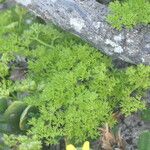Perennial to 1.6 m; roots numerous, slightly or distinctly fleshy, often fluted. Leaves drying at flowering, pinnately divided, glabrous, rachis curved, segments minute, linear-oblong. Inflorescence glabrous, yellowish brown. Flowers yellow. Fruit large, 8-12 mm long, oblong, mericarps isodiametric, heteromorphic, both with marginal wings but one with a median wing, other with a lateral wing, vittae present, rib oil ducts inconspicuous.
Perennial herb, up to ± 0.4-1.8 m high. Rootstock of many (15 or more), fascicled tubers, slightly or distinctly fleshy, often fluted. Leaves usually dry at flowering, finely dissected, trailing on long thin petioles and rachises, segments minute. Scapes almost leafless. Main umbel of 5-35 rays. Flowers pale yellow. Flowering time Aug.-Jan. Fruit with mericarps large, heteromorphic, distinctly winged, obovate.
A carrot like herb. The leaves and flowers appear at different times of the year. The leaves are divided several times with deep lobes in opposite pairs. The fruit are rounded. It has several fleshy roots. They have an anise like flavour.


